What makes Argentinian Asado Special?
Meat cooked on the barbecue, grill, or just a roast is something we are all familiar with. Each one has its methods, its secrets and magic, and its own fans. We also know that a barbecue is more than a meal: its a moment. It’s seeing those old friends, and it’s sharing with family. It is serving those we love, with what we know how to do best.
But what distinguishes Argentinian Asado from a BBQ? What’s its origin?
From the Top
In Argentina, the asado as we know it today arose with the gauchos. When the gauchos discovered beef (particularly ribs) they began to raise specimens to specifically consume them. In improvised holes that
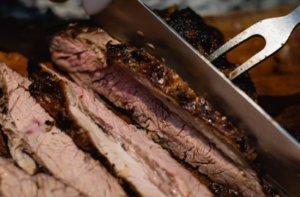
they made in the ground with their knives, they placed pieces of firewood and lit fire just like a modern firepit. When they reached fathoms, they placed the meat until it was slightly cooked on the outside and left raw on the inside. In the Argentinan Asado dictionary, we call this cooking method “arrebatado”.
Organically and unintentionally, the gauchos would lay the foundations of the Argentine barbecue, giving rise to the world-renowned and appreciated Argentine Asado. Let’s see what’s all about.
The Mysteries of the Argentine Barbecue
Cows And Cuts
The quality of the pastures, the climatic conditions and the extension of the Pampas plain resulted in a more than fertile field for raising cows. In a short time, hundreds and thousands of wild cows spread out through the fields and reproduced at a considerable rate. This wild cattle could be appropriated as long as it did not exceed 12,000 cows, as dictated by the law at that time.
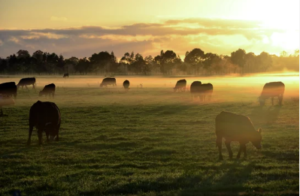
In the middle of the 18th century it was estimated that there were more than 40 million head of cattle. Then a new productive activity arose: salting. Raw meat began to be cut into strips 4 or 5 centimeters thick, dried in the sun until dehydrated, and preserved in brine barrels for later export.
Three breeds of cattle imported from England had been added to the free cattle: the Aberdeen Angus, the Hereford, and the Shorthorn. These began the era of pedigree specimens and ended with the Creole roast in a main dish that featured beef but also lamb, chicken and various types of sausages.
The Populars of the Asado
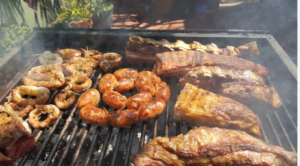
The following are the most outstanding cuts, visceras and sausages of the Argentinian Asado are:
- Bife de Chorizo, steak from the cow’s loin
- Tira de Asado, ribs
- Vacío, steak from the hind quarter
- Matambre, steak from between the ribs and the cowhide
- Tapa de Asado, steak from above the ribs
- Entraña, steak from inside the ribs
- Chorizo, a kind of saussage made of pork and cow’s meat
- Mollejas, meat from the throat
Both the visceras and the sausages are the first to be ready and reach the plates. Although we can count them as entries, Argentines are experts in enjoying the moment and food, so we think of entries outside the world of meat.
- Salads. The most popular are those that combine tomato, lettuce and onion, or onion, Parmesan and radicheta. But the star in question is the potato, egg and mayonnaise salad. We promise that combination is foolproof.

Provoleta - Grilled provolone or “Provoleta” . Its a melted and smoked cheese, crunchy on the outside and soft on the inside. Its a purely Argentine cheese created especially for the purpose of being able to be cooked on the grill. Because yes, everything we see, we want to do it on the grill.
- Empanadas. Empanadas are a separate main course, but in many homes and restaurants they can be found as a starter. They consist of a dough that generally contains meat, hard-boiled egg, olives, onion, oil and various spices, fried in animal fat. They are a show in themselves.
Wood and Cooking Pace
Ideally, one would have Quebracho wood to make the fire. This wood has unique characteristics that give the meat a special flavor. The quebracho is a hard wood, very aromatic and takes a long time to consume, which is why the meat cooks slowly, but taking on an incomparable flavor.
There are different ways to make Argentinian Asado:
To the Cross o “A la Cruz”
The technique consists of making a fire with wood, and around it placing pieces of meat fastened with stakes or stainless steel or iron crosses. The cuts of meat are going to be held vertically, so they must be held from 2, 3 or 4 vertices, and so that the thickest section of the cut is on the bottom side, that is, closer to the fire.
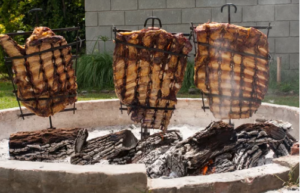
Its especially slow cooking requires a minimum of 3 hours to keep the fire on and at a constant temperature, but which results in tender, soft and well-done meat.
Rotisserie
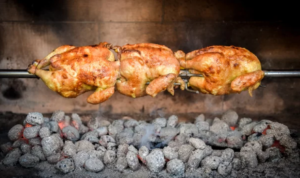
Its a style of grilling meat on a rotating skewer in front of a heat source. The rotation makes the roast homogeneous and the piece cooks in its own juices as it rotates. This way of roasting is used in the elaboration of grilled chicken.
Chulengo
Its a practical, economical cooking system that takes up little space and is easy to clean. Consists of a steel barrel lying on a support, with the top cut working as a “lid” to prevent thesmoke and heat from scaping. The coals are placed inside the barrel, and the meat on a grate inserted inside. On the other hand, its a mobile appliance, which helps when it comes to cooking in confined spaces or grilling in the yard, street or mountain.

It arose in the South of Argentina, due to the abundance of steel barrels that are used for oil deposits in Patagonia. In addition, oil tankers like to eat barbecue in the open field and, if the coals are not placed under a covered space, grilling in the open air becomes a complex activity.
Grill to the wall
There are two options to make the fire for an Argentinian Asado in a Traditional Domestic Grill. One is with Firewood, providing a woody and smoky flavor. The other, with Charcoal, which allows more precise temperature during cooking. When the fire and the meat are ready, you have to clean the grill with a wire or brush. You can find examples of these tools in our Grill Accessories Section.
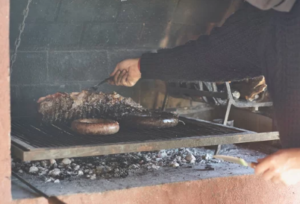
Once the fire is done and clarified, it’s time to take the meat and leave it on top of the grill. The key to an authentic Argentine barbecue is to regulate correctly the amount of heat and the distance of the meat from the grill. This way, one can achive the cooking point that they desire. The key is simply low and constant heat. The cuts of meat get juicy on the inside and marked on the outside without burning.
The different cuts of the Asado have, logically, different cooking, and its common to serve them as they are done. The visceras and sausages come out first, and the cuts of meat are ready a few minutes later. The meat is served on a tray, preferably with gutter on the edges to take advantage of the cooking juices. Look at our different Boards and Trays to serve Asado.
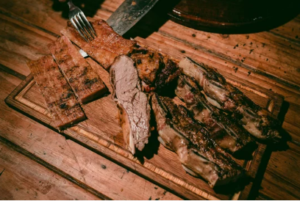
When it comes to cutting and serving meat, there are essential tools such as a Carving Set or Grill Set. The Carving allows to cut large pieces of meat with ease, and the Grill to control and serve the meat from a distance, preventing direct contact with the fire.
Additionals
Wine
Argentina has a high quality of wine production. Its characteristic strain is Malbec, originally from the south of France, cultivated in the most fertile lands in the province of Mendoza and San Juan. The Asado is usually accompanied with Malbec wine, since the tannins and woody aromas of the drink pair spectacularly with the meat and its mild smoked seasoning.

Picada
Every Asado begins with a picada. It doesn’t matter if you have few ingredients, it doesn’t matter if you have little quantity. We Argentines enjoy this appetizer or snack prior to Asado, which consists of small portions of different accompaniments. They can include different varieties of cheese, salami, bread, olives, snacks, and everything that the creativity of the diners suggests. They are prepared in different bowls or trays, such as our Pacara Wooden Trays or Tables, which allow for easy washing after use.
Choripán and various Breads

We Argentines usually eat some cuts of meat (if not all) between breads, giving it the character of a sandwich. The best known are the “Sandwich de Vacío”, “Sandwich de Entraña” and the popular and beloved “Choripán”. This allows a simple, fast and on-the-go intake, which gave rise to small grills on the sidewalk with sandwiches for sale, so that people can eat their Asado on the go every day.
Now, the Choripán is a separate issue, since only this combination of cow or pork chorizo inspired street food trucks that only specialized in choripanes. These are throughout the country, but the most famous in Buenos Aires are located on the Costanera Sur, near the Aeroparque Airport. It is a habit for people from Buenos Aires to go eat a choripán and watch the planes take off or land. It would be what we call a dinner show.
Chimichurri and Criolla Sauce
Chimichurri is a sauce from the Río de la Plata sector. It consists of a base of vinegar, parsley, garlic, vinegar, chili and salt. Now, there are two kinds of chimichurri. One can is mild, and the other strong. The difference between them resides on the greater or lesser presence of garlic in the preparation. For its part, the Criolla Sauce is made with chopped onion, bell pepper and tomato in brunoise. Then, it’s marinated with oil and vinegar.
Both are used to marinate and season meats on the plate or between breads.
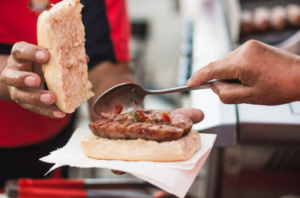
The Final Touch of the Argentinian Asado
So if you ever find yourself in Argentina, you already know where to go. “Parrillas”, “Puestitos de Choripanes” and even an Argentinian friend in the city, is waiting with a nice picada followed of some mollejas and chorizo, and fine cuts of meat. And the ultimate secret ingridient? Of course, the company, the laughs and the little pretty talks.

Asado for us, Argentines, it’s a ritual, a moment, a shared space where we can enjoy of ourselves, others and the food we make. It’s also, a celebration and a feast, something special we do just because we like apriciating the important things of life. That’s what you’ll get from an Argentinian Asado: good food and a nice warm feeling of love.
